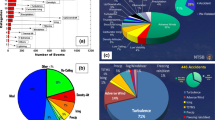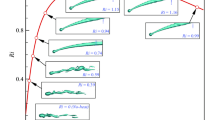Abstract
The results of experimental investigations into the action of polydispersion salt powders on model cloud media are presented. The results of experiments show a considerable positive effect of the modification of convective clouds by salt powders in order to obtain additional precipitation. The introduction of polydispersion salt powder into a forming cloud medium leads to the appearance of large cloud droplets and to the droplet-spectrum broadening. This result is a positive factor for the stimulation of coagulation processes and further precipitation formation. No “overseeding” phenomenon (when, instead of the enlargement of droplets, their sizes decrease and the concentration of cloud droplets increases) is observed at rather high mass concentrations of the introduced powder.
Similar content being viewed by others
References
G. K. Mather, D. E. Terblanche, F. E. Steffens, and L. Fletcher, “Results of South African cloud-seeding experiments using hygroscopic flares,” J. Appl. Meteorol. 36(11), 1433–1447 (1997).
R. T. Bruintjes, D. W. Breed, V. Salazar, M. J. Dixon, T. Kane, G. B. Foote, B. G. Brown, “Overview and results from the Mexican hygroscopic seeding experiment,” in Proceedings of the 15th Conference on Planned and Inadvertent Weather Modification (Am. Meteorol. Soc., 2001), pp. 45–48.
A. S. Drofa, “Investigation of the action of hygroscopic particles on a warm convective cloud from the results of numerical simulation,” Izv., Atmos. Ocean. Phys. 46(3), 328–338 (2010).
A. S. Drofa, “Formation of cloud microstructure during hygroscopic seeding,” Izv., Atmos. Ocean. Phys. 42(3), 326–336 (2006).
Y. Segal, A. Khain, M. Pinsky, and D. Rosenfield, “Effect of hygroscopic seeding on raindrop formation as seen from simulation using a 2000 bin spectral cloud parcel model,” Atmos. Res. 71, 3–34 (2004).
Y. Segal, M. Pinsky, and A. Khain, “The role of competition effect in the raindrop formation,” Atmos. Res. 83, 106–118 (2007).
R. Lahav and D. Rosenfeld, “The search for the optimal size of hygroscopic seeding particles,” Proceedings of the 16th Conference on Planned and Inadvertent Weather Modification (USA, San Diego, 2005), pp. 44–47.
D. Rosenfeld, D. Axisa, W. L. Woodley, and R. Lahav, “A quest for effective hygroscopic cloud seeding,” J. Appl. Meteorol. Clim. 49, 1548–1562 (2010).
A. S. Drofa, V. N. Ivanov, D. Rosenfeld, and A. G. Shilin, “Studying an effect of salt powder seeding used for precipitation enhancement from convective clouds,” Atmos. Chem. Phys. 10, 3335–3351 (2010).
G. A. Kolomiets and S. M. Kolomiets, “Laser analyzer of aerosol particles for air quality control,” Optiko-Mekhanicheskaya Promyshlennost’, No. 12, 21–24 (1989).
V. N. Panov and G. F. Yaskevich, “Aspekt-10 TV spectrometer of aerosols,” in Transactios of IEM (Gidrometeoizdat, Moscow, 1983), No. 7 (112), pp. 36–48 [in Russian].
W. A. Cooper, R. T. Bruintjes, and G. K. Mather, “Some calculations pertaining to hygroscopic seeding with flares,” J. Appl. Meteorol. 36(11), 1449–1469 (1997).
N. P. Romanov and G. P. Zhukov, “Thermodynamic relations for fog chambers,” Meteorol. Gidrol., No. 10, pp. 37–52 (2000).
N. P. Romanov, “Calculation of working parameters of 90-degree photoelectric counters,” in Transactions of IEM (Gidrometeoizdat, Moscow, 1991), No. 52 (147), pp. 92–108 [in Russian].
A. S. Drofa, V. N. Ivanov, and N. P. Romanov, and V. N. Stasenko, “Investigation of hygroscopic compounds efficiency for modification of warm convective clouds,” in Proceeding of the Scientific Conference on Weather Modification, WMP-N44 (Antalya, Turkey, 2007) pp. 48–50.
Author information
Authors and Affiliations
Corresponding author
Additional information
Original Russian Text © A.S. Drofa, V.G. Eran’kov, V.N. Ivanov, A.G. Shilin, G.F. Iskevich, 2013, published in Izvestiya AN. Fizika Atmosfery i Okeana, 2013, Vol. 49, No. 3, pp. 327–335.
Rights and permissions
About this article
Cite this article
Drofa, A.S., Eran’kov, V.G., Ivanov, V.N. et al. Experimental investigations of the effect of cloud-medium modification by salt powders. Izv. Atmos. Ocean. Phys. 49, 298–306 (2013). https://doi.org/10.1134/S0001433813030043
Received:
Accepted:
Published:
Issue Date:
DOI: https://doi.org/10.1134/S0001433813030043




